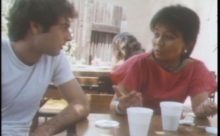Excerpt (2) from "Reaction" chapter of the book "Navajo Talking Picture: Cinema on Native Ground" by Randolph Lewis
I began collecting anonymous responses to the film in 2003, after noticing a strong audience response during a particular screening. Over the course of six years, I continued to teach the film at least once each year, usually in a course called “Documenting America,” sometimes in one called “Approaches to Media,” and occasionally in a guest lecture somewhere else. Each time I showed it without explaining too much about my own interpretations, instead asking students to keep some screening notes that I might collect and read in order to facilitate our discussion.
I was never disappointed. Students always gave me an earful in the classroom discussion and a good deal more in their written comments. Whenever I flipped through the anonymous responses that piled up at the end of a class, the first thing I noted was the intensity of the emotional engagement with what the students had seen. As a professor of film studies, I have taught scores of films in the past fifteen years, yet few of them have polarized audiences as much as this little-known documentary. Initially, I thought that the intensity of the sentiment was disproportionate to the film itself, and in this sense, I suspected that it was tied to deeper biases about Native art that Bowman seems to violate. “Indians (are) not supposed to be aggressive?” one student had wondered in his written response, touching on something that was often present, if only subtly, in the classroom discussion. Something about the film unsettled many of my students, most of whom were middle-class and upper-middle-class white Oklahomans, from small towns or midsized cities like Tulsa and Oklahoma City. Despite growing up in a state that bills itself as Indian country, and even despite some claims of distant Indian heritage, my students confessed to knowing nothing about Native American issues, past or present. For most of my students, Navajo Talking Picture was as exotic as something set in Saudi Arabia or Siberia, simply because they had never before seen a film in which Native issues, and Native people, were at the core.
In my experience, college students are not quick to ask ethical questions about the mainstream media that they consume so effortlessly, but such questions were often on their minds after watching Navajo Talking Picture. “I hope she’s just a ‘bad apple,”’ said one student, presumably hoping that other Native filmmakers were more sensitive, while four other students made the following comments:
“She should not have made the movie.”
“She had no right to make this movie.”
“Honest, traditional, forced, respectful, but somewhat selfish.”
“Revealing but intrusive.”
What seemed most galling to students was the apparent insensitivity of a young Native woman pestering her traditional grandmother. “It was very aggravating to watch,” wrote one student. “I really wanted to say to the filmmaker, ‘Listen. It doesn’t matter why your grandmother doesn’t want to do it. She doesn’t want you to do it. Maybe if you turn off the camera for a minute and really listen to her then you could get the information you came after.”’
Relatively few students tried to explain the perceived ethical lapses of Navajo Talking Picture rather than simply dismissing it outright as a monstrous undertaking. “The film is so blatantly insensitive that her ignorance could have been feigned,” one speculated, adding, “It is as if she wanted to confront her own insecurities about filmmaking.” Another was even more sympathetic: “Bowman sets out to tell a personal story, and the cultural truths she uncovers are incidental. She was not making a documentary about the ‘Navajo people.’ She is not trying to incorporate a comprehensive portrait of a culture. But I think because she tells such a specific and personal story it is a more valuable story. I think that is what makes the film unique and important.”
